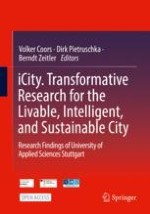16.1 Introduction
16.2 Background
16.2.1 Energy Data Simulation of the 3D Building Models
16.2.2 Energy Data Management
CityGML Application Domain Extension
SensorThings API (STA)
16.2.3 3D Data Visualisation (Digital Globe)
16.3 Concept
16.3.1 Computing and Visualising the Simulated Energy Data of 3D Building Models on-the-Fly
16.3.2 Using the PostgreSQL Database as a Datastore for the Simulated Energy Data of 3D Building Models
16.3.3 Using SensorThings for Managing the Simulated Energy Data of 3D Building Models
16.4 Implementation
16.4.1 Energy Simulation of the 3D Building Models with SimStadt Software
16.4.2 Managing Simulated Energy Data of 3D Building Models
Approach 1: Managing Simulated Energy Data of 3D Building Models on-the-Fly
Approach 2: Managing Simulated Energy Data of 3D Building Models Using a Database
Approach 3: Managing Simulated Energy Data of 3D Building Models Using OGC SensorThings API
16.5 Evaluation
Data management Features | Managing simulated energy data of 3D building models on-the-fly | Managing simulated energy data of 3D building models using a database | Managing simulated energy data of 3D building models using OGC SensorThings API | |
|---|---|---|---|---|
Data visualisation visualization | User interface for visualising building simulation on the web client | Users can input any parameters or scenarios on-the-fly | Users can only select pre-simulated scenarios | Users can only select pre-simulated scenarios |
User loading time for visualising building simulation | ~20–30 s per 100 buildings | ~1 to 2 s per 100 buildings | ~1 to 2 s per 100 buildings | |
Data organisation | Support data storage in the database | – | Supported | Supported |
Management of the multiple building simulation scenarios in the database | – | Manually manage with an additional application layer, e.g. node.Js server | Organised by SensorThings data model in the Datastream entity | |
Role-based data access to the simulation data | – | Accessible only to the database administrators. Role-based access control can be extended | Different authentication roles can be given to users (read, write, update, delete, and admin) | |
Interface to access, add, update, and delete the data in the database | – | Manually manage with an additional application layer, e.g. Node.js server | Users with appropriate roles can access, add, update, and delete data through the REST-based protocol | |
Building simulation data distribution | – | The API to allow data access can be extended. The API document must be added | The data can be access through SensorThings interface. The standard API document is provided by OGC | |
